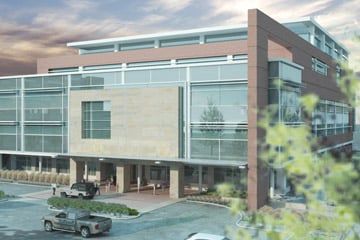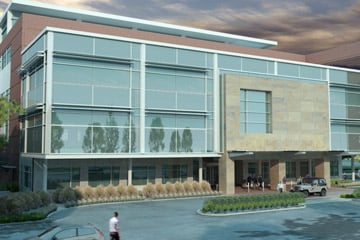
By: Jacque Montgomery | University Communications
AURORA, Colo. - More than 75,000 patients trust their eye health to the physicians and practitioners at the University of Colorado Eye Center at the Anschutz Medical Campus. That number is expected to grow to more than 150,000 patients in the coming years. Meeting the needs of those patients and continuously improving the high quality of care offered to them requires a significant expansion of the current eye center.
The University of Colorado Hospital’s Rocky Mountain Lions Eye Institute today broke ground on an expansion project that will nearly triple the size of the institute. More than 135,000 square feet will provide additional space for the current services as well as house a specialized ophthalmology surgery center. At the center of the project is a research area that will support state-of-the-art laboratories which will build on the recent discoveries by the ophthalmologists and scientists in the University of Colorado School of Medicine. The team was first to research stimulation of the retina with photovoltaic nanoparticles, which have the potential to restore sight to patients with blinding retinal diseases. The Eye Center was the first academic medical center in the United States to commercially perform femtosecond laser-assisted cataract surgery.
“The expansion allows us to do what we love to do most – take care of our patients in the very best way possible by offering them the latest in care – while at the same time discovering new approaches to that care so that we can preserve each patient’s ability to read, drive and recognize loved ones,” said Naresh Mandava, MD, executive director of the University of Colorado Eye Center, professor and chair of the Department of Ophthalmology at the University of Colorado School of Medicine and Sue Anschutz-Rodgers chair in retinal diseases.

Education and innovation are at the heart of the expansion as the team of eye experts hopes to connect with patients like never before. Programs of excellence including a macular degeneration center, glaucoma center, ophthalmic translational research center, ocular stem cell transplantation center, ocular gene therapy center and the visual sciences innovation center will all expand on the standard of care while creating new treatments to address conditions that steal sight including blindness, glaucoma, childhood diseases, macular degeneration and more.
“We want to move the rate of change in eye care faster than it’s ever moved,” said Mark Petrash, PhD, head of research for the department. “The eye center has been transformational in taking discoveries in the lab and making them available to patients. With this focus on research, we will bring sight to life in ways never before imagined.”
At the expansion ceremony, the CU School of Medicine and the Department of Ophthalmology announced a new $6.5 million gift from The Anschutz Foundation, with $4 million allocated to the Eye Center capital expansion and $2.5 million to the ophthalmology research program. Campus officials also acknowledged a significant expansion investment from the CU School of Medicine. The Anschutz gift follows two others from local donors who said thanks by supporting faculty research and retention: Sue Anschutz-Rodgers gave $2 million to establish an endowed chair in retinal diseases (held by Naresh Mandava, MD), and Craig Slater and his wife, Colleen, donated $1.5 million that established the Slater Family Endowed Chair in Ophthalmology (held by Malik Kahook, MD).
Mortenson Construction is the general contractor overseeing the expansion project. Patients will continue to be seen at the Rocky Mountain Lions Eye Institute while construction is underway, and every effort will be made to minimize the impact of construction on patient care. The project is expected to be completed by fall 2014.
